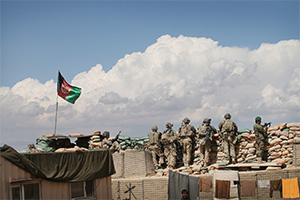Money as a weapons System
How U.S. Commanders Spent $2 Billion of Petty Cash in Afghanistan
During a decade of war, the Pentagon gave more than $2 billion to commanders to spend as they wished on a broadly defined grab bag of “urgent humanitarian” needs. The goal was to gain support from the locals for both the U.S. military and the nascent Afghan government. It was, the military said: “money as a weapons system.”
Soldiers and Marines became construction foremen and contract managers, insurance adjustors and business advisers, social workers and health officials.
The Afghan money pot sprang out of a case that the military had made in Iraq in 2003: The U.S. could douse violent insurgencies by buying the local population what it lacked, including electricity, jobs, roads, schools, even chickens. Paired with vital protection from the U.S. military, the cash could become “ammunition,” said now-retired Gen. David Petraeus, the architect of the plan. So began the Commander’s Emergency Response Program, or CERP.
With a thriving insurgency, rampant corruption, increasing illegal trade and other ills still plaguing Afghanistan, critics have questioned whether CERP really bought anything grander than the projects themselves. Still, a perusal of the commanders’ “hearts and minds” shopping lists provides a unique window into war, exposing the unusual frontline bartering by service members who would swap, say, a school, for security.
The records for this money are, at first glance, nothing more than boring military-ese, but look closer and they reveal captivating miscellany and just how fascinating and absurd the war could be.
What Can You Find?
“Per the contractor — they were just being ‘greedy bastards’…”
What America Bought and Why
Click on a box to explore
“…demolish area of mosque formerly used as machine gun bunker…”
Kim Bazaar Mosque Refurbishment
Poetry Competitions and Community Radio: $20,665
Radio Surobi, Key to Winning Hearts and Minds
“Walk-through style metal detectors are especially useful when prison staffing is minimal and visitor volume is high.”
“Success. Supplies distributed to the Afghans to sustain them through the winter. Hearts and minds won!”
“Yet another glitch in the extreme failure of a system that we call CIDNE.”
“Replacing the black tiles with white tiles have decreased the number of burn injuries”
Blue Mosque Renovations
“The surviving family now has a suitable place to live.”
Qalat Rebuild
SOURCES
Illustrations: Sarah Way for ProPublica. Data: Assembled from several different Department of Defense databases by the Special Inspector General for Afghanistan Reconstruction and provided to ProPublica under a Freedom of Information Act Request.
Billions Blown in Afghanistan Reconstruction Spending? (MuckReads Edition)
Our Hottest Stories
- The Muscular Dystrophy Patient and Olympic Medalist with the Same Genetic Disorder
- I Ramped Up My Internet Security, and You Should Too
- An Unbelievable Story of Rape
- Nursing Assistant Fired, Charged After Posting Nude Video of 93-Year-Old on Snapchat
- Afghanistan Waste Exhibit A: Kajaki Dam, More Than $300M Spent and Still Not Done
- Opting out: Inside corporate America’s push to ditch workers’ comp
- ProPublica Summer Data Institute
- How Denmark Dumped Medical Malpractice and Improved Patient Safety
- Why ProPublica Joined the Dark Web
- Mass Surveillance in America: A Timeline of Loosening Laws and Practices

After routing the Taliban in Afghanistan in 2001, the U.S. government began a now 13-year effort to stabilize and develop the country. It has cost taxpayers billions — and some say, achieved little. These stories examine the waste and problems plaguing U.S. reconstruction efforts that, despite the end of combat, will continue to cost billions — even as our military presence shrinks.
We are also investigating the failures, and would like to hear from people involved in U.S. reconstruction in Afghanistan.
What went wrong? Share your story.
After troops leave, U.S. to lose access to Afghan reconstruction projects worth billions (The Washington Post, October 2013)
Once the troops leave Afghanistan, U.S. officials lose access to reconstruction projects worth billions of dollars http://t.co/GeYZF4HBVa
— W.J. Hennigan (@wjhenn) October 27, 2013
“By plotting some of the largest civilian and military projects on a map generated by the inspector general’s office, The Post found that at least 15 major reconstruction initiatives, projected to cost more than $1 billion, are expected to be beyond the reach of U.S. government personnel next year.”
Afghans don’t like soybeans, despite a big U.S. push (Center for Public Integrity, July 2014)
The fuller story on Washington’s insane $34 million Afghanistan reconstruction-by-soybean project. http://t.co/Kx3itjqB7K
— Byron York (@ByronYork) July 24, 2014
“As one of the project’s managers said, it was a ‘risky but honorable endeavor,’ meant to improve the nutrition of malnourished Afghans by raising the level of protein in their diets. As such, the project’s problems model the larger shortcomings of the estimated $120 billion U.S. reconstruction effort in Afghanistan, including what many experts depict as ignorance of Afghan traditions, mismanagement and poor spending controls.”
The Real Reason the US Military Was So Secretive About Afghanistan (VICE News, February 2015)
.@ElSnarkistani: ‘Americans will pay for US hubris in Afghanistan a long time but the real losers are the Afghans’ https://t.co/NVB7e1BBpq
— Alice Speri (@alicesperi) February 2, 2015
“[General John F. Campbell, commander of all foreign forces in Afghanistan] doesn’t want anyone to know how badly things are going in Afghanistan. So he’s classified any information related to the capacity of Afghan forces, including how much money is being spent to build the Afghan army.”
Two charts that prove the Afghan drug war is a total failure (VOX, July 2014)
“But according to SIGAR, eradication has also been a total failure. From 2008 to 2013, when the US anti-opium campaign hit its apex, the US only managed to eradicate 3.7 percent of the land devoted to poppy cultivation. The total amount of land devoted to poppy cultivation was a third higher in 2013 than in 2008.”
After billions in U.S. investment, Afghan roads are falling apart (The Washington Post, January 2014)
“Now, if we drive too fast, everyone in the car dies.” After billions in US funding, Afghan roads fall apart http://t.co/tsxgynmVtr @ksieff
— Ron Lin, LA Times (@ronlin) January 31, 2014
“The new, U.S.-built highways seemed to be a godsend for this impoverished nation. But the projects became notorious for their exorbitant costs and poorly implemented contracts. Sometimes, money landed in the hands of the Taliban in exchange for a tacit cease-fire during road construction.”
A Rebuilding Plan Full of Cracks (The Washington Post, November 2005)
“The U.S. effort was poorly conceived in a rush to show results before the Afghan presidential election in late 2004. The drive to construct earthquake-resistant, American-quality buildings in rustic villages led to culture clashes, delays and what a USAID official called ‘extraordinary costs.’ “

Megan McCloskey
Megan McCloskey covers the military for ProPublica. Previously she was the national correspondent at Stars and Stripes.








